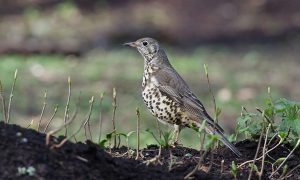
The thing about working on roofs is that you get to know your birds. We’ve had a cocky little critter strutting about the garden for several weeks – in fact, there it is now – and when Mick the roofer came he identified it as a mistle thrush. This was later confirmed by Dave the builder.
The mistle thrush, they told me, is the largest of the thrushes and the biggest song bird in the UK. It’s certainly chirpy. And it issues a tut-tut-tut sound of disapproval if any other bird dares to venture onto its patch. Even ravens get the treatment. It divebombs them from trees and tuts at them until they amble off elsewhere to get some peace.
The thing that Mick and Dave weren’t able to divulge is why it’s called a mistle thrush. Why the mistle? In fact, why the thrush? How did such an elegant bird come to share its name with an unpleasant fungal infection? And if you’re giggling at that in a Life of Brian/Bigus Dickus sort of way, wait till you hear its Latin name. Turdus viscivorus. Yep.
Mistle has had several meanings over the years. It’s a way of spelling that mixture of mist and drizzle, which is normally spelt mizzle; it’s a shelter for cattle; and it used to be an alternative spelling of mussel. Three uses that no-one ever uses. None of which sheds any light on why the mistle thrush should be so called.
But the viscivorus bit does. Well, up to a point. This word comes from the Latin viscum (mistletoe) and vorare (to eat). Apparently mistle thrushes like to eat mistletoe berries. That would explain it. But then, like the chicken and the egg, you have to ask yourself where mistletoe got its name. Was it used for healing people who were missing a toe? Probably not. One theory is that it is so called because it is seeded from the droppings of the mistle thrush, which brings us back in a Möbius strip to the original question.
So we are stuck with this word ‘mistle’ which has no known meaning. And when I look at the mistle thrush, that’s what I see: a bird that’s looking for meaning, a bird in search of itself.


